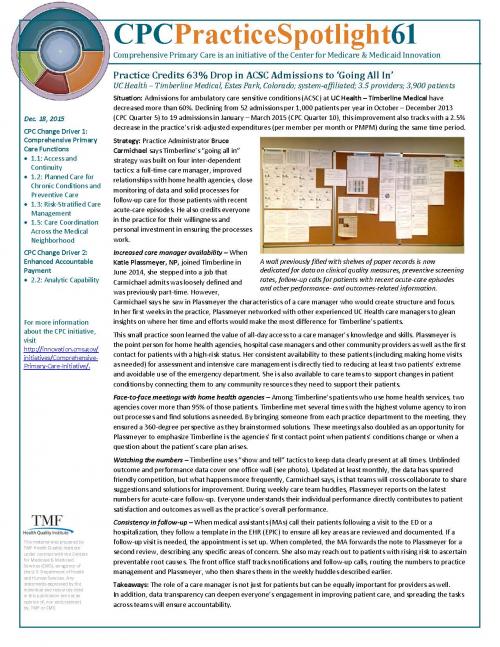
Practice Credits 63% Drop in ACSC Admissions to ‘Going All In’
UC Health – Timberline Medical, Estes Park, Colorado; system-affiliated; 3.5 providers; 3,900 patients
Situation: Admissions for ambulatory care sensitive conditions (ACSC) at UC Health – Timberline Medical have decreased more than 60%. Declining from 52 admissions per 1,000 patients per year in October – December 2013 (CPC Quarter 5) to 19 admissions in January – March 2015 (CPC Quarter 10), this improvement also tracks with a 2.5% decrease in the practice’s risk-adjusted expenditures (per member per month or PMPM) during the same time period.
Strategy: Practice Administrator Bruce Carmichael says Timberline’s “going all in” strategy was built on four inter-dependent tactics: a full-time care manager, improved relationships with home health agencies, close monitoring of data and solid processes for follow-up care for those patients with recent acute-care episodes. He also credits everyone in the practice for their willingness and personal investment in ensuring the processes work. Increased care manager availability – When Katie Plassmeyer, NP, joined Timberline in June 2014, she stepped into a job that Carmichael admits was loosely defined and was previously part-time. However, Carmichael says he saw in Plassmeyer the characteristics of a care manager who would create structure and focus. In her first weeks in the practice, Plassmeyer networked with other experienced UC Health care managers to glean insights on where her time and efforts would make the most difference for Timberline’s patients. This small practice soon learned the value of all-day access to a care manager’s knowledge and skills. Plassmeyer is the point person for home health agencies, hospital case managers and other community providers as well as the first contact for patients with a high-risk status. Her consistent availability to these patients (including making home visits as needed) for assessment and intensive care management is directly tied to reducing at least two patients’ extreme and avoidable use of the emergency department. She is also available to care teams to support changes in patient conditions by connecting them to any community resources they need to support their patients. Face-to-face meetings with home health agencies – Among Timberline’s patients who use home health services, two agencies cover more than 95% of those patients. Timberline met several times with the highest volume agency to iron out processes and find solutions as needed. By bringing someone from each practice department to the meeting, they ensured a 360-degree perspective as they brainstormed solutions. These meetings also doubled as an opportunity for Plassmeyer to emphasize Timberline is the agencies’ first contact point when patients’ conditions change or when a question about the patient’s care plan arises.
Watching the numbers – Timberline uses “show and tell” tactics to keep data clearly present at all times. Unblinded outcome and performance data cover one office wall (see photo). Updated at least monthly, the data has spurred friendly competition, but what happens more frequently, Carmichael says, is that teams will cross-collaborate to share suggestions and solutions for improvement. During weekly care team huddles, Plassmeyer reports on the latest numbers for acute-care follow-up. Everyone understands their individual performance directly contributes to patient satisfaction and outcomes as well as the practice’s overall performance.
Consistency in follow-up – When medical assistants (MAs) call their patients following a visit to the ED or a hospitalization, they follow a template in the EHR (EPIC) to ensure all key areas are reviewed and documented. If a follow-up visit is needed, the appointment is set up. When completed, the MA forwards the note to Plassmeyer for a second review, describing any specific areas of concern. She also may reach out to patients with rising risk to ascertain preventable root causes. The front office staff tracks notifications and follow-up calls, routing the numbers to practice management and Plassmeyer, who then shares them in the weekly huddles described earlier.
Takeaways: The role of a care manager is not just for patients but can be equally important for providers as well. In addition, data transparency can deepen everyone’s engagement in improving patient care, and spreading the tasks across teams will ensure accountability.
| Attachment | Size |
|---|---|
| 251.06 KB |

